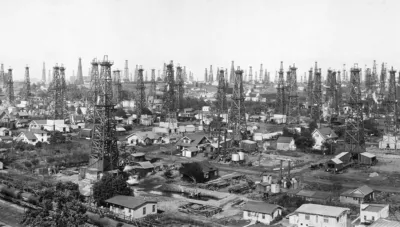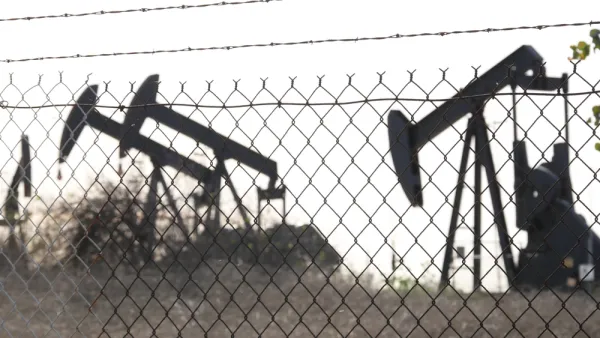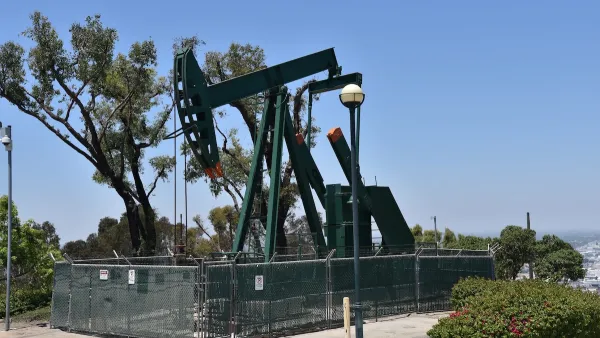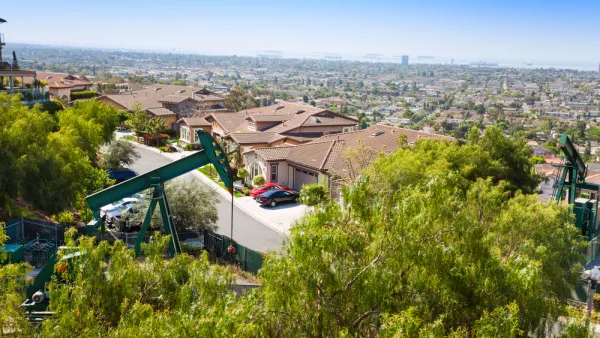Much of California's oil and gas extraction takes place in residential neighborhoods, posing significant health risks to entire communities.

"Every year, upward of 140 million barrels of oil are extracted from the state of California," writes Judith Lewis Mernit for Yale Environment 360. But "unlike more rural oil-producing states, where oilfields might be uninhabited but for the people who work on them, drilling in California happens to a large degree in residential settings."
"In Signal Hill to the south near Long Beach, drilling rigs butt up against playgrounds," while a wall obscures an active oil well just behind the Beverly Center, a posh mall in Los Angeles. "In addition to drilling operations, refineries in the Los Angeles and San Francisco Bay areas, handle some of the dirtiest oil in the world, from Alberta’s Athabasca oil sands to the state’s own carbon-heavy crude," writes Mernit. According to a 2020 analysis by FracTracker Alliance, over 7 million Californians live within a mile of an oil or gas well.
Despite "a mountain of evidence saying that living close to oil and gas wells is harmful to human health," between 2015 and 2020 California "issued more than 25,000 permits for drilling new wells and redrilling older ones, more than 60 percent of them in Spanish-speaking communities." But with "plenty of other culprits for polluted air," the connection is often difficult to prove. A surprising absence of data on the subject "makes it easier for petroleum’s boosters in the state to claim that oil activity does not pose a health hazard for nearby communities, and harder for legislators to protect their constituents from what they insist is making them sick."
Although "Oil industry advocates contend that California has the toughest environmental laws for petroleum extraction in the world," spotty enforcement, low fines, and exemptions for small producers—"the ones in neighborhoods, in people’s backyards"–have led to an unchecked proliferation of wells in residential areas and farms.
In recent years, cities around the country have taken steps to mitigate the impacts of urban oil drilling and limit new wells near homes and schools. "In 2013, the Dallas City Council passed an ordinance prohibiting new drilling within 1,500 feet of sensitive developments," while "[i]n Los Angeles, site of the country’s largest urban oil field, the city council is considering an ordinance to outlaw oil drilling within the city completely." But with oil companies lobbying to block such legislation, advocacy groups express cautious optimism for incremental victories.
FULL STORY: The Oil Well Next Door: California’s Silent Health Hazard

National Parks Layoffs Will Cause Communities to Lose Billions
Thousands of essential park workers were laid off this week, just before the busy spring break season.

Retro-silient?: America’s First “Eco-burb,” The Woodlands Turns 50
A master-planned community north of Houston offers lessons on green infrastructure and resilient design, but falls short of its founder’s lofty affordability and walkability goals.

Delivering for America Plan Will Downgrade Mail Service in at Least 49.5 Percent of Zip Codes
Republican and Democrat lawmakers criticize the plan for its disproportionate negative impact on rural communities.

Test News Post 1
This is a summary

Test News Headline 46
Test for the image on the front page.

Balancing Bombs and Butterflies: How the National Guard Protects a Rare Species
The National Guard at Fort Indiantown Gap uses GIS technology and land management strategies to balance military training with conservation efforts, ensuring the survival of the rare eastern regal fritillary butterfly.
Urban Design for Planners 1: Software Tools
This six-course series explores essential urban design concepts using open source software and equips planners with the tools they need to participate fully in the urban design process.
Planning for Universal Design
Learn the tools for implementing Universal Design in planning regulations.
EMC Planning Group, Inc.
Planetizen
Planetizen
Mpact (formerly Rail~Volution)
Great Falls Development Authority, Inc.
HUDs Office of Policy Development and Research
NYU Wagner Graduate School of Public Service





























